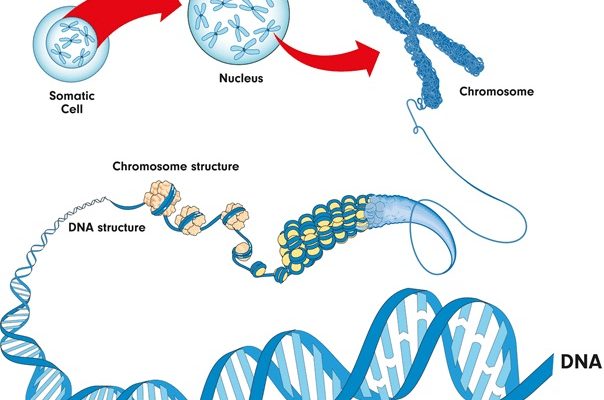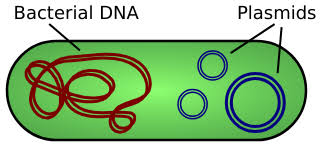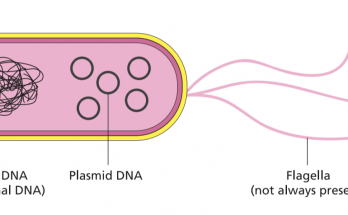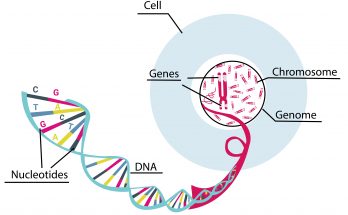Students, if you have any queries, please leave a comment below! I will try my best to answer your queries with more details.
The difference between DNA and chromosomes is fundamental to the study of genetics and molecular biology. DNA (Deoxyribonucleic Acid) is the hereditary material in humans and almost all other organisms. Each cell in an organism has the same DNA, which is composed of a long chain of nucleotides structured into a double helix. Chromosomes, on the other hand, are key organisational structures within the cell’s nucleus that package and manage DNA, allowing for efficient replication and distribution during cell division. This article explores the distinctions and functions of DNA and chromosomes, shedding light on their crucial roles in genetics and cellular biology.
Table of Contents
DNA (Deoxyribonucleic Acid)
- Definition- DNA is a long, double-stranded molecule composed of nucleotides. Each nucleotide consists of a sugar molecule (deoxyribose), a phosphate group, and one of four nitrogenous bases—adenine, thymine, cytosine, or guanine.
- Structure- The structure of DNA is that of a twisted ladder, famously known as the double helix.
- Location- DNA is primarily found within the nucleus of a cell.
- Function-
- Genetic Blueprint- DNA stores the genetic instructions necessary for the development, functioning, and reproduction of living organisms.
- Replication and Transmission- DNA replicates itself during cell division, ensuring that genetic information is accurately passed from one generation to the next.
- Mutation and Regulation- DNA undergoes mutations, which can lead to genetic variations, and plays a critical role in regulating gene expression.
Chromosome
- Definition- A chromosome is a highly organised structure containing condensed DNA, wound around histone proteins.
- Structure- Chromosomes are made up of tightly coiled DNA and protein, forming a complex known as chromatin during certain stages of cell division.
- Location- Like DNA, chromosomes are located in the nucleus of cells.
- Function-
- Gene Regulation- Chromosomes facilitate the regulation of gene activity within the DNA strand.
- Genetic Distribution- During cell division, chromosomes ensure that DNA is correctly distributed to daughter cells.
6 Key Differences Between DNA and Chromosomes in Tabular Format
| Aspect | DNA | Chromosome |
| Definition | A molecule made up of nucleotide monomers. | A structure containing DNA and proteins. |
| Composition | Composed of nucleotides with bases A, T, C, G. | Composed of DNA and histone proteins. |
| Structure | Double helix made of two nucleotide strands. | Organised structure of condensed DNA and proteins. |
| Location | Located in the nucleus and some organelles. | Strictly found in the nucleus during cell division. |
| Function | Carries genetic instructions and undergoes replication. | Facilitates gene regulation and equal DNA distribution during cell division. |
| Identification | Identified by techniques like gel electrophoresis. | Identified through karyotyping or microscopy. |
Differences Between DNA and Chromosomes Explained In Details
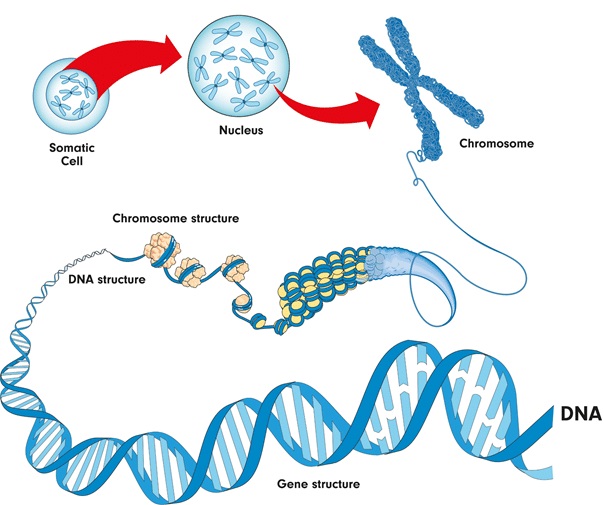
Definition
- DNA (Deoxyribonucleic Acid)- DNA is the genetic material found in most living organisms and some viruses, characterised by its structure as a double-stranded helix of nucleotides. Each strand consists of a backbone made from sugar and phosphate groups, with nitrogenous bases extending from the sugar and pairing across the strands.
- Chromosome- Chromosomes are key cellular structures that organise and condense DNA into a more manageable form for cell division. They ensure that DNA is correctly replicated and distributed to new cells during division, and they are crucial for maintaining the integrity and regulation of the genetic information.
Also Check – 6 Key Differences Between DNA and Genes
Composition
- DNA- The composition of DNA is relatively simple yet highly variable due to the sequences of its nucleotides—adenine, thymine, cytosine, and guanine. These bases pair specifically (A with T and C with G) to form the steps of the helical ladder.
- Chromosome- A chromosome’s composition is more complex, involving DNA wrapped around histone proteins, creating a structure known as a nucleosome. This combination of DNA and protein helps in the supercoiling and further organisation into the compact structure of the chromosome, which is essential during cell division.
Structure
- DNA- The structure of DNA is a flexible yet stable double helix that allows it to store vast amounts of genetic information in a compact form. The helical structure is critical for the processes of replication and transcription.
- Chromosome- Chromosomes exhibit a highly organised and condensed structure, particularly during mitosis and meiosis, when they become visible under a microscope as distinct entities. This supercoiling and condensation are vital for the chromosomes’ functions during cell division.
Location
- DNA- DNA is primarily located in the nucleus of eukaryotic cells and in the cell’s organelles such as mitochondria and chloroplasts, where it performs various functions related to energy production and photosynthesis, respectively.
- Chromosome- Chromosomes are always found in the nucleus and play a critical role during the cell division process. They become highly visible and distinguishable during this phase due to their condensed state.
Function
- DNA- The primary function of DNA is to store and transmit genetic information to the next generation. It serves as the blueprint for all cellular processes and the organism’s development.
- Chromosome- The main function of chromosomes is to manage and regulate the expression of genetic material during the cell cycle. They ensure that DNA replication and distribution during cell division are accurate, preventing genetic disorders and maintaining the stability of the genome.
Also Check – Origin and Evolution of DNA and DNA Replication Machineries
Role in Genetics
- DNA- DNA contains all the genetic instructions necessary for building and maintaining an organism. These instructions dictate everything from physical appearance to physiological processes.
- Chromosome- Chromosomes play a pivotal role in genetics by ensuring that these genetic instructions are executed properly. They organise the DNA in a way that enables efficient replication and distribution to daughter cells, and they regulate genetic expression through mechanisms that affect the structure of chromatin.
Also Check – 4 Important Differences Between Genes and Chromosomes
Frequently asked Question on DNA and Chromosomes
What is the structure of DNA?
- Answer- DNA is structured as a double helix, consisting of two long strands of nucleotides that twist around each other. Each nucleotide is made up of a phosphate group, a sugar molecule (deoxyribose), and one of four nitrogenous bases- adenine, thymine, cytosine, or guanine.
Describe the composition of a chromosome.
- Answer- A chromosome is composed of DNA tightly coiled around proteins called histones. This complex of DNA and protein is referred to as chromatin.
Also Check – 8 Key Differences Between Plasmid DNA and Chromosomal DNA
How does the structure of DNA differ from that of a chromosome?
- Answer- DNA itself is a double helix structure made of nucleotides, while a chromosome is a more complex structure consisting of DNA wound around histone proteins, which helps organise and condense the DNA to fit within the cell nucleus, especially during cell division.
What are the main functions of DNA?
- Answer- The main functions of DNA include storing genetic information, guiding the synthesis of proteins, and regulating cellular functions through transcription. DNA also replicates itself to ensure genetic continuity during cell division.
What role do chromosomes play in a cell?
- Answer- Chromosomes play a crucial role in ensuring the accurate distribution of DNA during cell division. They also help regulate gene expression by altering the structure of chromatin to either expose or hide DNA regions from the cellular machinery that reads DNA.
Where is DNA located within a cell, and how does this differ from the location of chromosomes?
- Answer- DNA is located in the nucleus of eukaryotic cells, as well as in organelles like mitochondria and chloroplasts. Chromosomes, which are structures formed by DNA and proteins, are also located in the nucleus but become particularly visible and distinct during cell division.
Explain how DNA and chromosomes are identified in the laboratory.
- Answer- DNA can be identified and analysed through techniques like gel electrophoresis, which separates DNA fragments based on size. Chromosomes are typically identified through karyotyping or microscopy, techniques that allow scientists to observe the distinct structures and number of chromosomes.
What is the significance of the chromosome structure during mitosis and meiosis?
Answer- During mitosis and meiosis, the chromosome structure becomes highly condensed and visible, which is significant for the accurate segregation of chromosomes into daughter cells. This ensures that genetic information is evenly and correctly distributed, maintaining genetic stability across generations.
